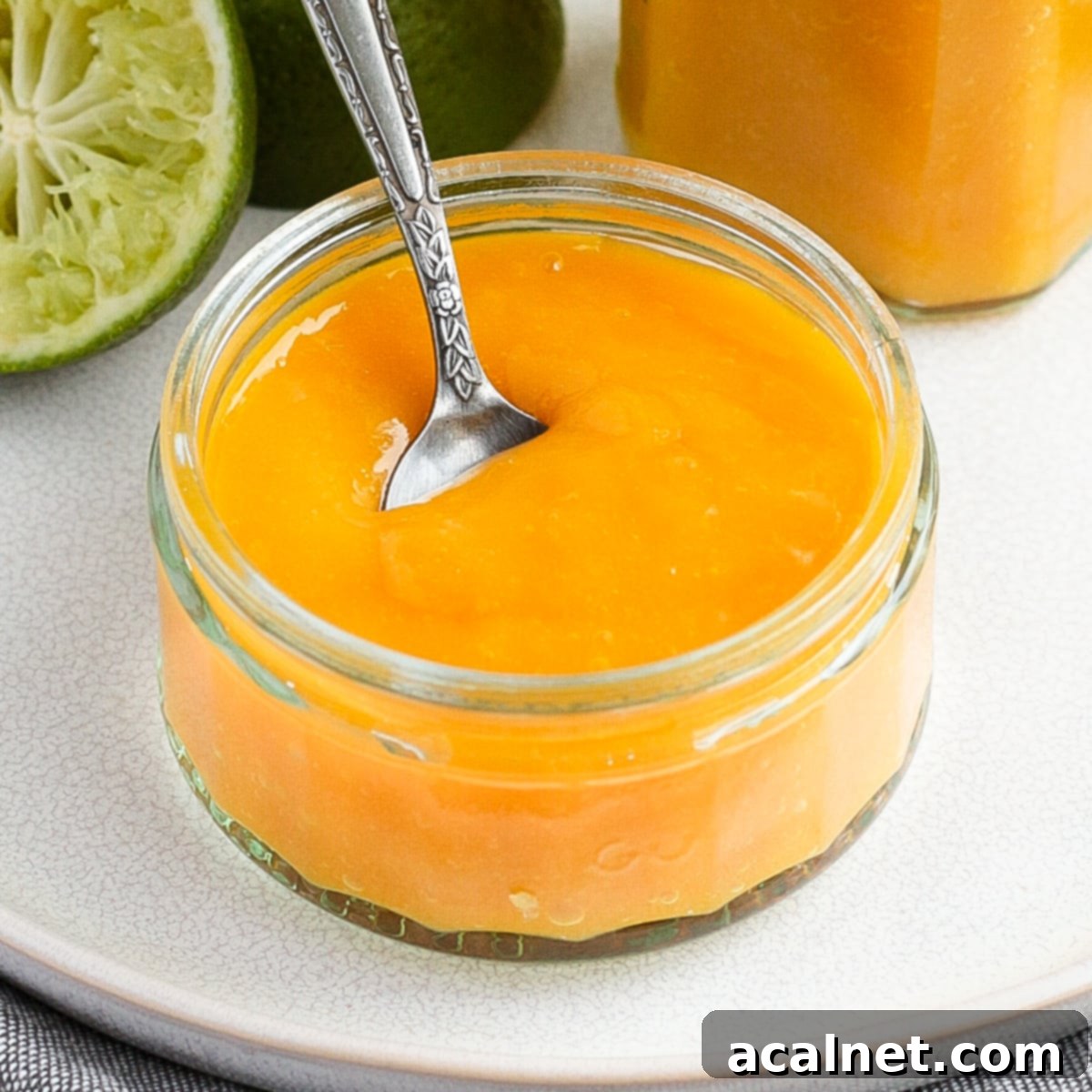Easy 3-Ingredient Mango Coulis: The Perfect Tropical Dessert Sauce
Transform your desserts, breakfasts, and baked goods with this incredibly easy Mango Coulis recipe! Made with just three simple ingredients, this vibrant, thick, and utterly delicious mango sauce is bursting with tropical flavor. It’s the ultimate versatile topping that adds a touch of sunshine to almost any sweet creation. Whether you’re dressing up a simple breakfast or adding a gourmet touch to a sophisticated dessert, this homemade mango coulis is a game-changer you’ll want to keep on hand.
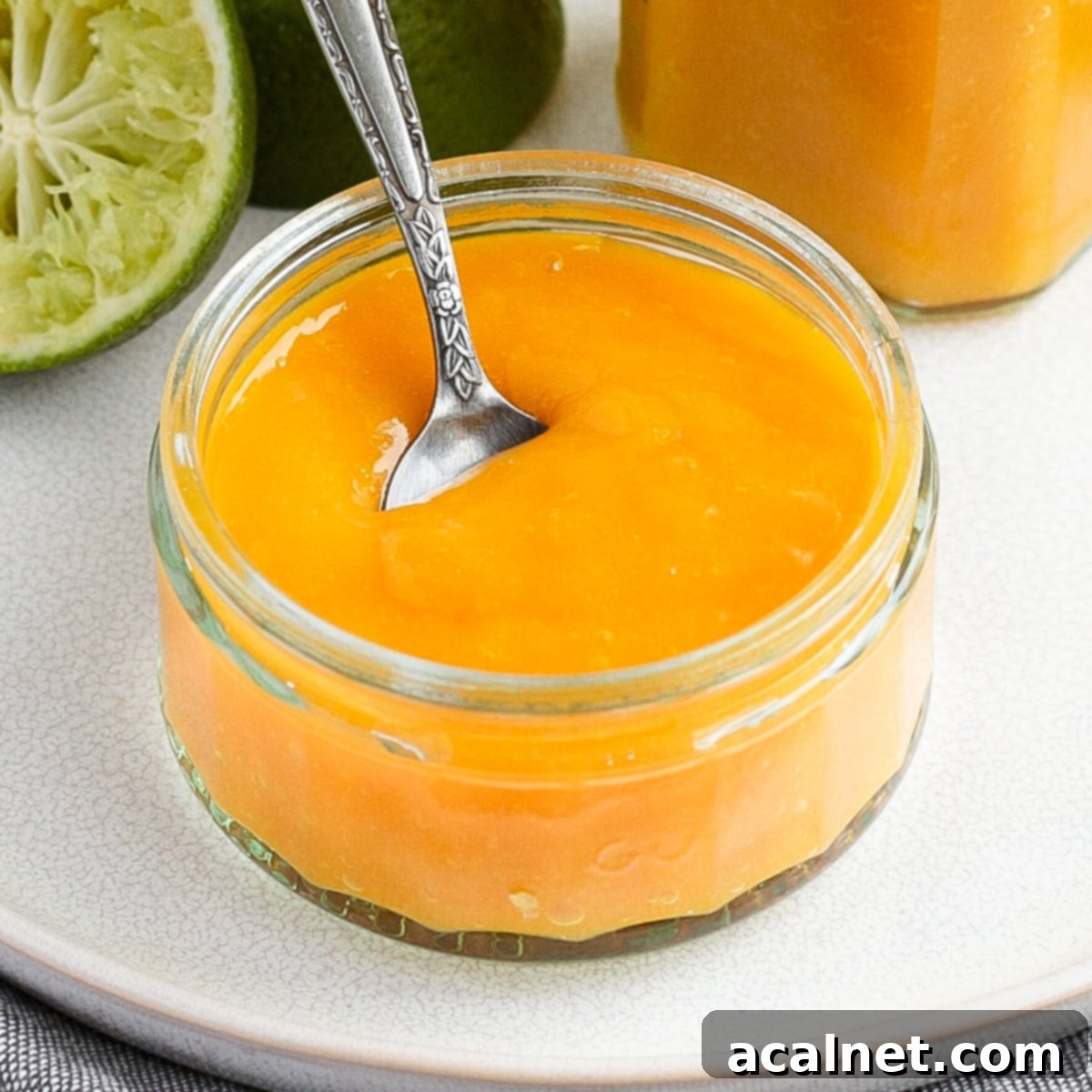
[feast_advanced_jump_to]
Why You’ll Adore This Homemade Mango Coulis
This easy mango coulis recipe is more than just a sauce; it’s an instant mood booster, bringing a burst of tropical sunshine to any plate. Its naturally sweet and tangy profile, combined with the exotic aroma of fresh mango, makes it an irresistible addition to all your sweet indulgences. It’s surprisingly simple to make, proving that gourmet flavors don’t always require complex steps or a long list of ingredients.
While this sweet mango sauce excels as a versatile dessert or breakfast topping, its uses extend far beyond. I particularly love how it complements a creamy Mango Cheesecake or adds an extra layer of flavor to a decadent Mango Mousse Cake. Imagine it drizzled generously over fluffy pancakes, golden waffles, or classic French toast for an elevated breakfast experience. But don’t stop there! This luscious sauce can also serve as a foundational element for crafting other exquisite desserts, such as a silken Mango Panna Cotta or a light and airy Mango Mousse. Its vibrant color and refreshing taste are sure to impress every time.
What Exactly is a Coulis?
A coulis (pronounced “koo-LEE”) is a culinary term of French origin, referring to a thick, smooth sauce made from puréed fruits or vegetables. In the context of desserts, it’s typically a sweet fruit sauce that has been cooked, blended, and often strained to achieve a beautifully uniform and refined texture. Unlike a simple fruit puree, a coulis is almost always strained after blending to remove any seeds, pulp, or fibrous bits, resulting in an exceptionally smooth and elegant consistency that is ideal for drizzling and garnishing.
Just like its berry counterparts, such as strawberry, raspberry, passion fruit, or blueberry coulis, this mango version adheres to the classic three-ingredient formula: the fruit itself, a touch of sugar for sweetness and preservation, and a hint of acidity from lemon or lime juice to brighten the flavors. This simple combination ensures that the natural essence of the mango truly shines through.
It’s important to distinguish a coulis from other fruit preparations. While a fruit puree involves blending cooked or raw fruit until smooth, it isn’t necessarily strained, meaning it might retain some texture. A fruit compote, on the other hand, typically consists of cooked fruit pieces that are intentionally left chunky and are not blended at all. The signature smoothness of a coulis is what truly sets it apart, making it a sophisticated choice for enhancing any sweet dish.
Only 3 Ingredients Needed for this Homemade Mango Sauce
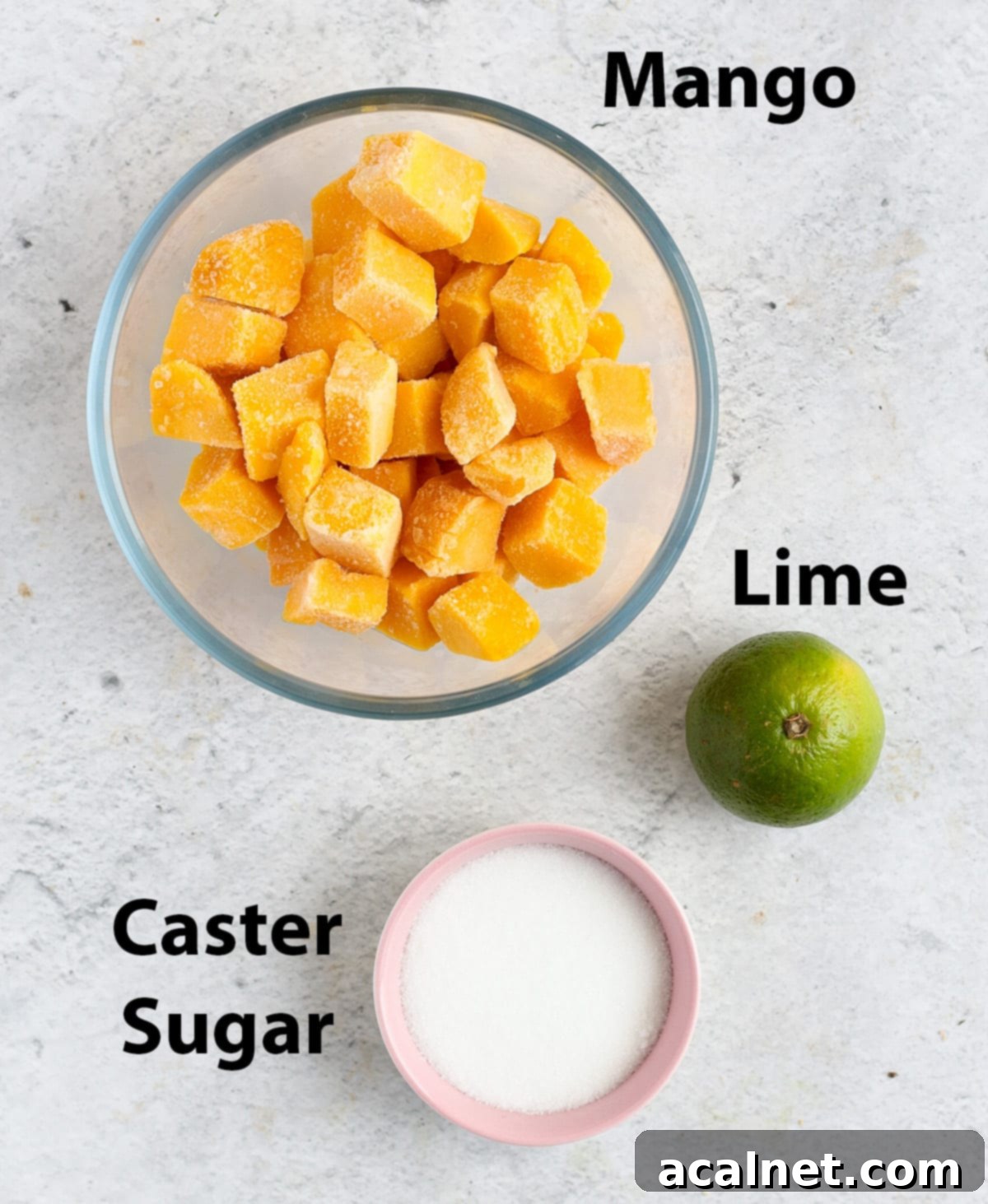
This delightful mango sauce is incredibly straightforward to prepare, calling for a minimalist approach with just three essential ingredients. Each plays a crucial role in creating the perfect balance of flavor, texture, and natural sweetness.
- Mango: Naturally, the star of our show! For the best results, always aim for a ripe and fragrant mango. Varieties like Ataulfo (Honey Mango), Alphonso, or Haden are known for their rich, sweet flavor and less fibrous flesh, which is ideal for coulis. A ripe mango will yield easily to gentle pressure and emit a sweet aroma near the stem. Unripe mangoes tend to be fibrous and can introduce a sour note, requiring more sugar to balance. You can use either fresh or frozen mango pieces; both work wonderfully. If using fresh, make sure to peel and cube it carefully.
- Caster Sugar: Also known as fine white sugar, caster sugar dissolves quickly and evenly, ensuring a smooth sauce without a grainy texture. While I prefer caster sugar for its clean sweetness, you could also experiment with brown sugar for a slightly deeper, more caramel-like flavor profile. The sugar isn’t just for sweetness; it also helps in the gentle caramelization of the fruit during cooking and acts as a natural preservative, extending the shelf life of your coulis. It also contributes to the desired thick consistency.
- Lime Juice: This zesty ingredient is key to balancing the natural sweetness of the mango. Lime juice adds a bright, fresh tang that prevents the sauce from being overly sweet and highlights the complex tropical notes of the mango. While lemon juice is a common substitute, I find that lime juice offers a slightly milder, more aromatic sourness that beautifully complements mango. Beyond flavor, the acidity from the lime juice also aids in the thickening process, helping the coulis set to a perfect, spoonable consistency without becoming runny.
The synergy between these three ingredients is what makes this mango coulis so special. The sugar gently cooks the fruit, creating depth of flavor and a natural thickening effect. The lime juice cuts through the richness, adding a refreshing zest that elevates every bite. Together, they create a sauce that is both luxurious and incredibly vibrant.
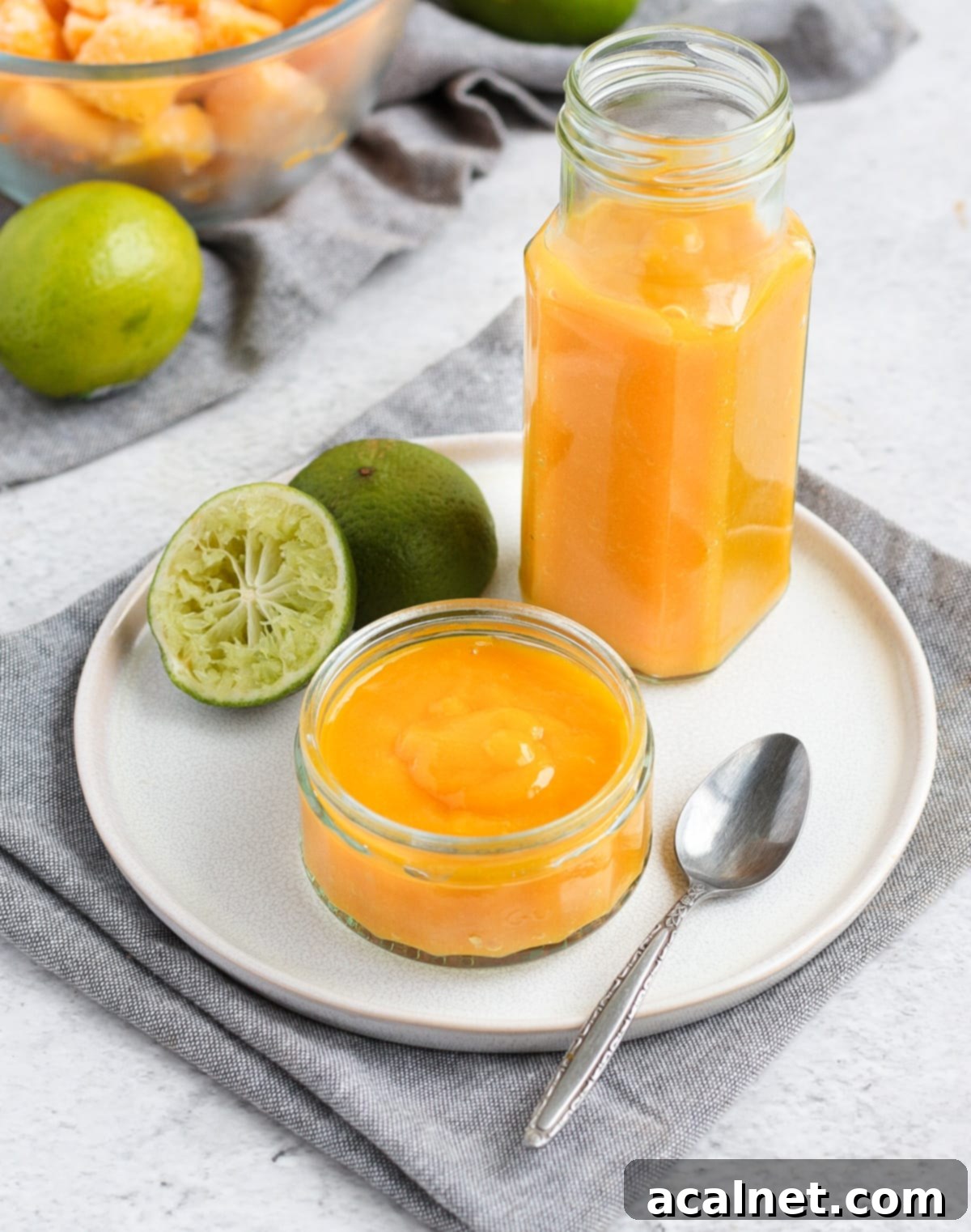
How to Make Homemade Mango Coulis
Creating this delicious mango coulis is a straightforward process that will have you enjoying a homemade gourmet sauce in no time. Similar to my popular Strawberry Coulis or Raspberry Coulis, this recipe involves just a few simple steps, making it perfect for both novice and experienced cooks.
- Prepare the Mango: If using fresh mango, carefully peel it and cut the flesh into small, even-sized cubes. The smaller the cubes, the quicker and more evenly they will cook. Place these mango cubes into a small saucepan. If you’re using frozen mango, you can simply add the frozen chunks directly to the pot, no thawing required beforehand.
- Combine Ingredients: Add the measured Caster Sugar and fresh Lime Juice to the saucepan with the mango. Stir all the ingredients together thoroughly to ensure the mango pieces are well coated. This step helps the sugar begin to dissolve and evenly distribute the lime juice for balanced flavor. – photo 1
- Cook the Fruit: Place the saucepan over low to medium heat. Allow the mixture to cook for approximately 10 to 15 minutes, or until the mango pieces become very soft and begin to break down easily. It’s crucial to stir the mixture occasionally to prevent the fruit from sticking to the bottom of the pan and potentially burning. If you’re using frozen mango straight from the freezer, you might notice it sticking a bit at the start; a tablespoon or two of water can help it thaw gently. Continue cooking until the mango is incredibly tender. – photo 2
- Cool and Blend: Once the mango is perfectly soft, remove the saucepan from the heat and let it cool for about 5 minutes. This brief cooling period makes it safer to blend. Then, use an Immersion Blender to blend the cooked fruit directly in the pot. Blend until the mixture is exceptionally smooth, ensuring there are absolutely no chunks or fibers remaining. A truly smooth coulis is key! – photo 3 and 4
- Adjust Flavor (Optional but Recommended): At this stage, taste your freshly blended coulis. Depending on the natural sweetness of your mango, you might want to adjust the flavor. If it’s too tart, add a little more sugar. If it’s too sweet, a squeeze of additional lime juice will brighten it up. Adjust to your personal preference.
- Strain for Ultimate Smoothness (Optional): For the silkiest, most refined coulis, you can optionally pour the blended sauce through a fine-mesh sieve. This step will remove any lingering fibers or tiny, unblended fruit particles, creating a truly luxurious texture. Keep in mind that mango coulis is naturally quite thick, so you might need to use a sieve with a slightly larger mesh size or gently push the coulis through with a spoon. If it’s too thick to strain, blend in a tiny bit of water to thin it slightly.
(*) The exact cooking time for the mango will vary based on its ripeness, variety, and whether you’re using fresh or frozen fruit. Very ripe fresh mango might only need about 5 minutes of cooking. Always monitor the pot closely and stir consistently until the mango is incredibly tender and falling apart. This ensures optimal flavor and texture for your coulis.
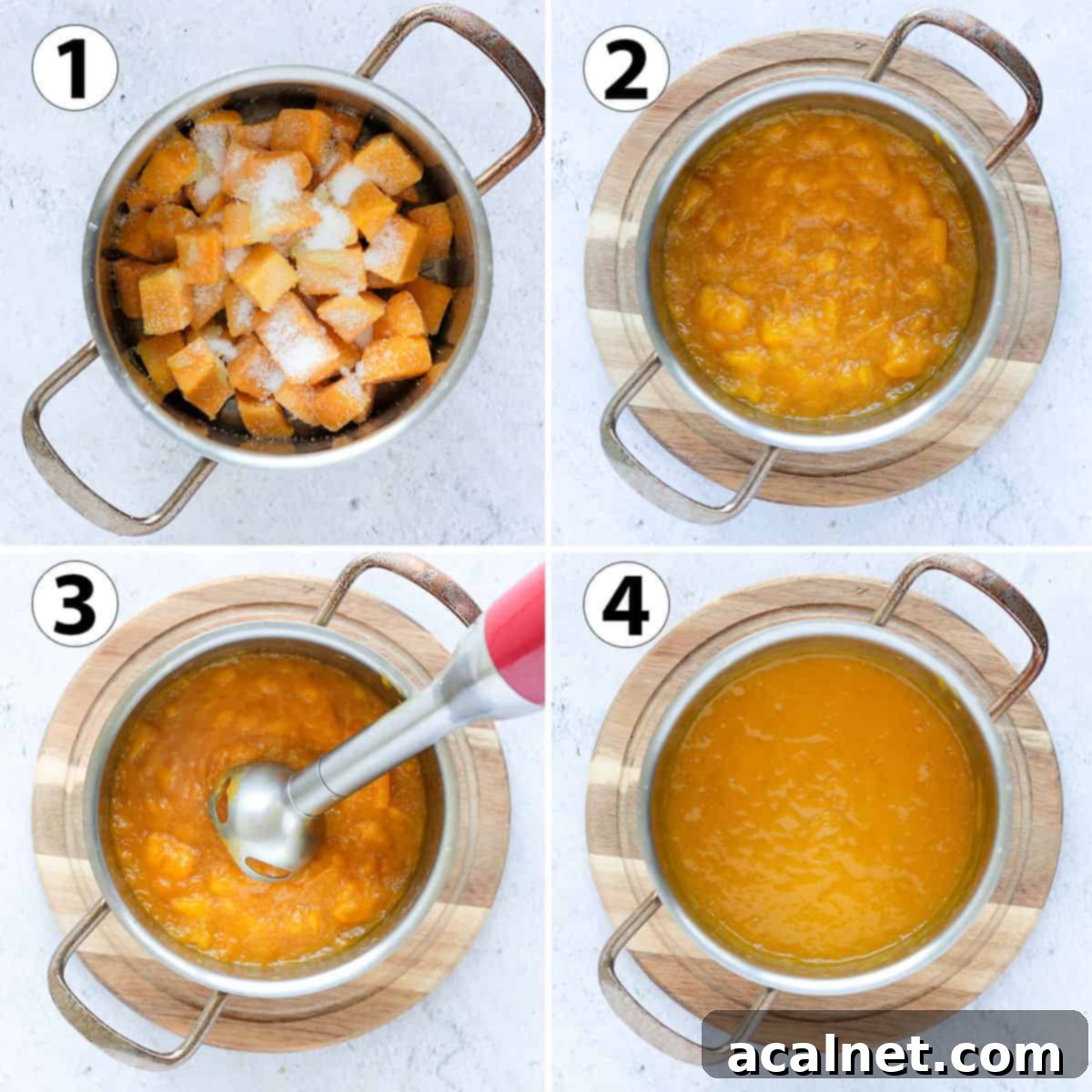
Essential Tips for the Best Mango Coulis
Achieving the perfect mango coulis is simple with these helpful tips, ensuring a smooth, flavorful, and beautifully textured sauce every time:
- Constant Stirring is Key: Never leave your mango on the stove unattended. The natural sugars in the fruit will begin to caramelize quickly. Without occasional stirring, the mango can easily stick to the bottom of the pan and burn, which will impart an unpleasant bitter taste to your coulis. Keep a close eye and stir frequently to ensure even cooking.
- Monitor Cooking Time: The cooking duration is highly variable. It depends on several factors, including the ripeness of your mango, the specific variety you’re using, and whether it’s fresh or frozen. The goal is to cook the fruit until it is incredibly soft and almost completely falling apart. A very ripe fresh mango, cut into small cubes, might be ready in as little as 5 minutes, while firmer or frozen mangoes will take longer.
- Handling Frozen Mango: If you opt for frozen mango, which is a convenient choice, you might need to add a splash of water (1-2 tablespoons) to the pot at the beginning. This helps the frozen fruit thaw gradually without sticking or scorching before it releases its own juices.
- Taste and Adjust Seasoning: Mangoes vary greatly in their natural sweetness and acidity depending on the variety and ripeness. Therefore, the exact amount of sugar and lime juice needed can differ. Always taste your coulis after blending. If it’s too tart, add a little more sugar, a teaspoon at a time, until balanced. If it’s too sweet, a dash more lime juice will brighten it up beautifully. Don’t be afraid to adjust to suit your palate!
- Choosing the Right Mango: For the best flavor, select mangoes that are ripe but firm. They should have a sweet, fragrant aroma and give slightly when gently squeezed. Avoid mangoes that are too soft or have large bruises.
- Equipment Matters: An immersion blender is highly recommended for achieving the smoothest texture directly in the pot, minimizing cleanup. If you don’t have one, a regular blender will work, but be cautious with hot liquids and blend in batches, ensuring the lid is securely on and vented.
Troubleshooting Common Mango Coulis Issues
Even with a simple recipe, minor issues can arise. Here’s how to troubleshoot some common problems you might encounter while making your mango coulis:
The Sauce is Too Thick
Mangoes naturally cook down into a relatively thick consistency due to their pectin content and low water release compared to some other fruits. If your coulis is thicker than desired, it’s an easy fix: simply add a little bit of water. Start by stirring in 1 or 2 tablespoons of water, then use your immersion blender again to fully incorporate it and achieve a smoother, more liquid consistency. You can add more water, one tablespoon at a time, until you reach your preferred texture.
The Sauce is Too Liquid
A runny coulis usually indicates that the fruits weren’t cooked long enough, meaning too much of their natural water content hasn’t evaporated. Don’t worry, it’s rectifiable! Return the blended coulis to the stove and allow it to simmer gently over low heat. Stir occasionally and let it reduce, evaporating excess moisture, until it thickens to your desired consistency. Be patient, as this might take a few extra minutes, but it’s essential for a perfectly spoonable sauce.
The Coulis is Not Smooth Enough
The hallmark of a great coulis is its velvety smooth texture. If your coulis has lingering chunks or feels fibrous, you have a couple of effective options:
- Continue Blending: Often, the simplest solution is to keep blending for a few more minutes. Mango can be quite fibrous, and it requires thorough blending to break down all the fruit fibers. Ensure your immersion blender reaches all parts of the pot, or process it longer in a stand blender.
- Strain Again: For a truly professional and silken finish, pour the coulis through a fine-mesh sieve. This will capture any remaining fibers, small chunks, or impurities. If the coulis is too thick to easily pass through the sieve, you can blend in a tablespoon or two of water to thin it slightly, making the straining process easier. Remember that mango coulis is inherently thick, so you might need to use a sieve with a slightly wider mesh or gently push it through with a spatula.
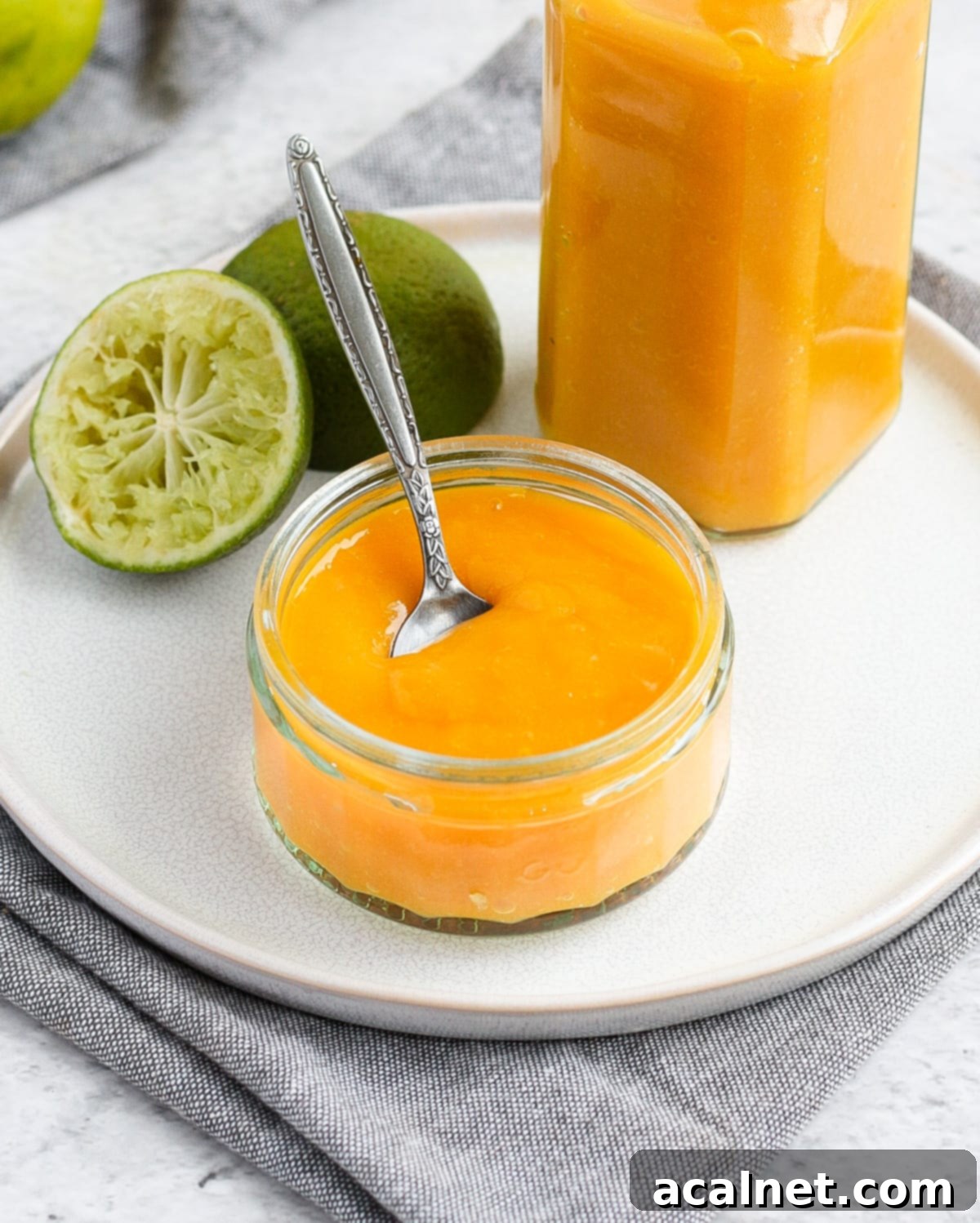
Recipe FAQs: Your Questions About Mango Coulis Answered
Absolutely! Frozen mangoes are a fantastic and convenient option for this recipe, especially when fresh mangoes are out of season or costly. I often use them myself. You might find that frozen fruits require a slightly longer cooking time to thaw completely and soften. Additionally, keep an eye on the pot, as frozen mangoes can sometimes stick to the bottom more readily initially. If this happens, simply add a tablespoon or two of water to help them release and continue cooking smoothly.
While it’s possible to use liquid sweeteners like honey, maple syrup, or agave nectar, I generally don’t recommend them if you’re aiming for the classic thick consistency of a coulis. Liquid sweeteners tend to make the sauce more runny and it won’t set or thicken as much as it would with granulated sugar. This is because granulated sugar aids in the caramelization and structural integrity of the sauce. However, if you prefer a thinner, more pourable or runny mango sauce and don’t mind the difference in texture, then liquid sweeteners can certainly be used to add sweetness.
Once your mango coulis is ready, allow it to cool down completely to room temperature. This is important to prevent condensation inside the container, which can lead to spoilage. Once cooled, transfer the coulis to an airtight jar or container. Store it in the refrigerator, where it will remain fresh and delicious for up to 1 week. Always check for any signs of spoilage before consuming if it has been stored for a longer period.
Yes, this mango coulis freezes exceptionally well, making it a perfect make-ahead component for various desserts. It can be stored in the freezer for up to 3 months without losing its flavor or quality. For ultimate convenience, I highly recommend freezing it in individual portions. Small silicone molds, ice cube trays, or even small freezer-safe containers are ideal for this. This way, you can easily thaw just the right amount whenever you need a burst of tropical flavor, minimizing waste and maximizing freshness.
The versatility of mango coulis is one of its greatest assets! It’s fantastic drizzled over ice cream, yogurt, or oatmeal for a simple yet delicious treat. Use it as a vibrant topping for pancakes, waffles, or French toast. It pairs beautifully with rich desserts like cheesecakes, panna cotta, pavlova, or even chocolate cake. For a lighter option, serve it with fresh fruit salads or incorporate it into cocktails and mocktails for a tropical twist. You can also layer it in parfaits or use it as a base for smoothies and mousses.
This mango coulis recipe is naturally vegan as it uses only fruit, sugar, and lime juice. To make it sugar-free, you can substitute the caster sugar with a sugar alternative like erythritol or stevia, keeping in mind that the texture might be slightly thinner as sugar also aids in thickening. Adjust the quantity of the sweetener to your taste, as different alternatives have varying levels of sweetness. The cooking process and storage instructions remain the same.
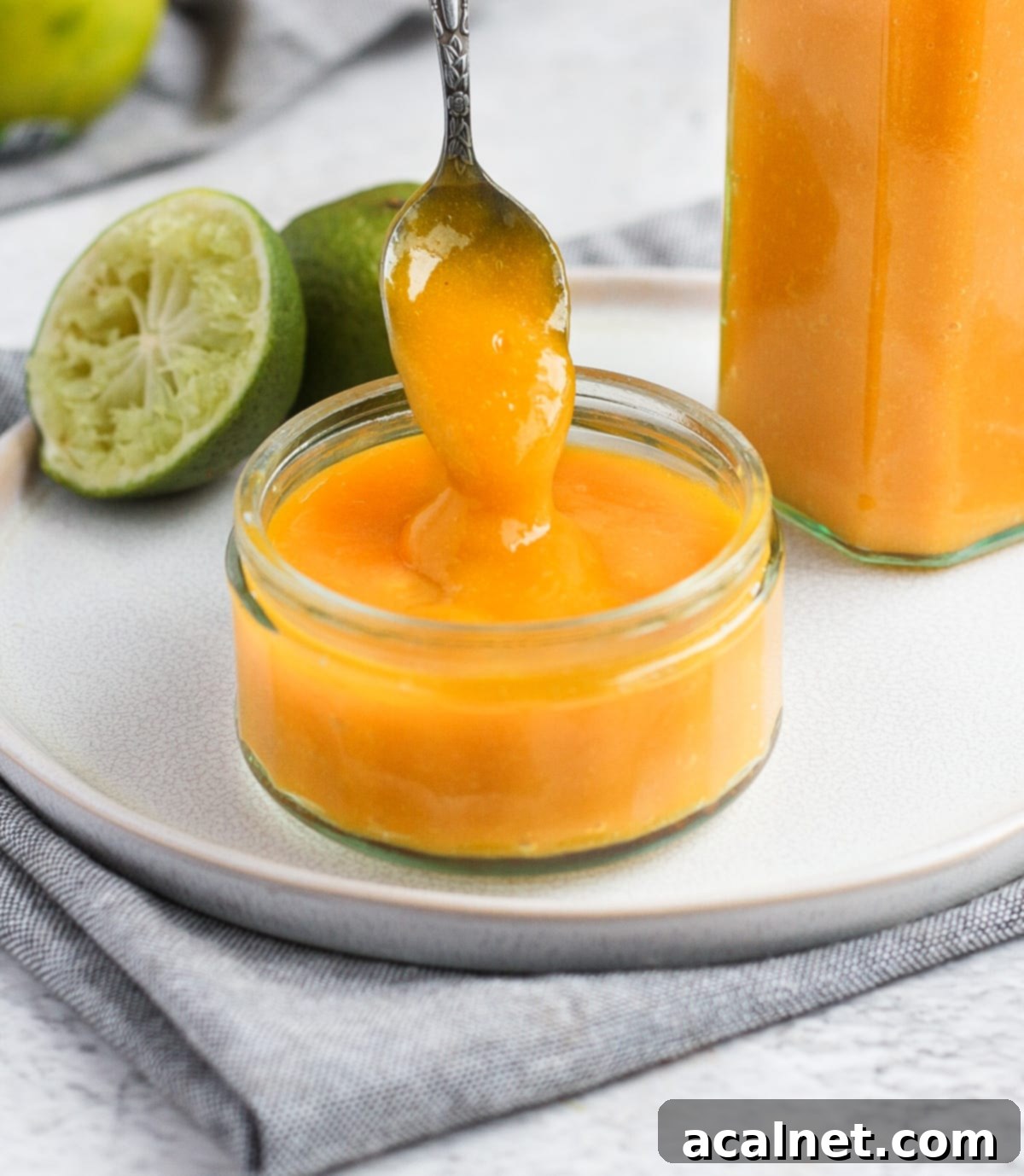
More Delicious Sweet Sauces & Toppings to Try
If you loved this simple mango coulis, you’re in for a treat! Exploring the world of homemade sweet sauces and toppings opens up a realm of possibilities for elevating your culinary creations. From zesty curds to comforting compotes, these recipes are designed to add a special touch to your favorite desserts and breakfasts. Here are some more delightful options to inspire your baking journey:
- Mango Curd
- Stewed Rhubarb
- Mixed Berry Compote
- Orange Curd
- Homemade Applesauce
- Easy Blueberry Compote
- Tangy Lemon Curd
- Strawberry Compote
- Raspberry Compote
Made this recipe?
We love to see your creations! Let us know if you enjoyed this recipe by leaving a comment below, and be sure to tag us on Instagram @a.baking.journey with a photo of your delicious mango coulis!
Recipe Card

3 Ingredients Mango Coulis
Yields: 1 1/2 cups (approx. 400g)
Author:
Sylvie
10 minutes
10 minutes
20 minutes
Print Recipe
Prevent your screen from going dark
Ingredients
- 400 gr Mango Flesh, fresh or frozen, peeled and cubed
- 30 ml Fresh Lime Juice
- 50 gr Caster Sugar
Instructions
- Peel and slice the Mango into small cubes and place them into a small saucepan (see note 1 if using frozen mango).
- Add the Caster Sugar and Lime Juice, then stir well to combine all ingredients.
- Cook on low to medium heat for about 10 to 15 minutes (see note 2 for variations), or until the fruit is very soft and starts to fall apart. Stir occasionally to prevent sticking and burning. Remove the saucepan from the stove and let the mixture cool for about 5 minutes.
- Using an Immersion Blender, blend the cooked mango until it is exceptionally smooth. This may take a few minutes to ensure no fibrous pieces or chunks remain, resulting in a thick and creamy sauce.
- Once blended, taste the coulis. Adjust the sweetness or acidity by adding a little more sugar or lime juice if needed, according to your preference (see note 3).
- Optional: For an even smoother and potentially thinner sauce, strain the coulis through a mesh sieve. This step removes any remaining fibers or unblended fruit particles (see note 4 for straining tips).
- Allow the mango coulis to cool down completely before transferring it to a sealed jar or container. Store it in the fridge for up to one week.
Would you like to save this recipe?
We’ll email this post to you, so you can come back to it later!
Notes
- Using Frozen Mangoes: If you’re using frozen mango cubes, you can place them directly into the saucepan from the freezer. Initially, they might stick to the bottom of the pot or struggle to thaw. If you observe this, add 1 or 2 tablespoons of water to the pot. This small amount of liquid will help the mango thaw gently and prevent it from scorching before it starts releasing its own juices.
- Variability in Cooking Time: The time required for the mango to soften completely can differ significantly. Factors include the ripeness of the mango (very ripe mangoes cook faster), its specific variety, and whether it’s fresh or frozen. For instance, a very ripe, fresh mango cut into small cubes might become tender in just 5 minutes. It’s crucial to stay close to the stove and stir the fruits consistently until they are thoroughly soft and begin to fall apart, indicating they are ready for blending.
- Adjusting Sweetness and Acidity: Mangoes vary widely in their natural sweetness and tartness based on their variety, quality, and ripeness level. It’s highly recommended to taste your coulis after it has been blended. If you find it too sweet, a little extra lime juice will add a refreshing tang. If it’s too tart, gradually stir in a bit more sugar until you achieve your preferred balance of flavors. This tasting step is essential for a perfectly balanced coulis.
- Straining for Smoothness: Mango coulis has a naturally thick consistency. If you choose to strain it for an ultra-smooth texture, you might find that a very fine-mesh sieve is too restrictive. Consider using a sieve with a slightly larger mesh size to facilitate the straining process. Alternatively, if the coulis is too thick to pass through your sieve, you can blend in a small amount of water (1-2 tablespoons) to thin it slightly, making it easier to strain while still maintaining its rich flavor.
Nutrition (per serving)
Calories: 364kcal
|
Carbohydrates: 92g
|
Protein: 3g
|
Fat: 2g
|
Saturated Fat: 1g
|
Sodium: 5mg
|
Potassium: 672mg
|
Fiber: 6g
|
Sugar: 85g
|
Vitamin A: 4328IU
|
Vitamin C: 155mg
|
Calcium: 44mg
|
Iron: 1mg
Read this recipe as a Web Story
